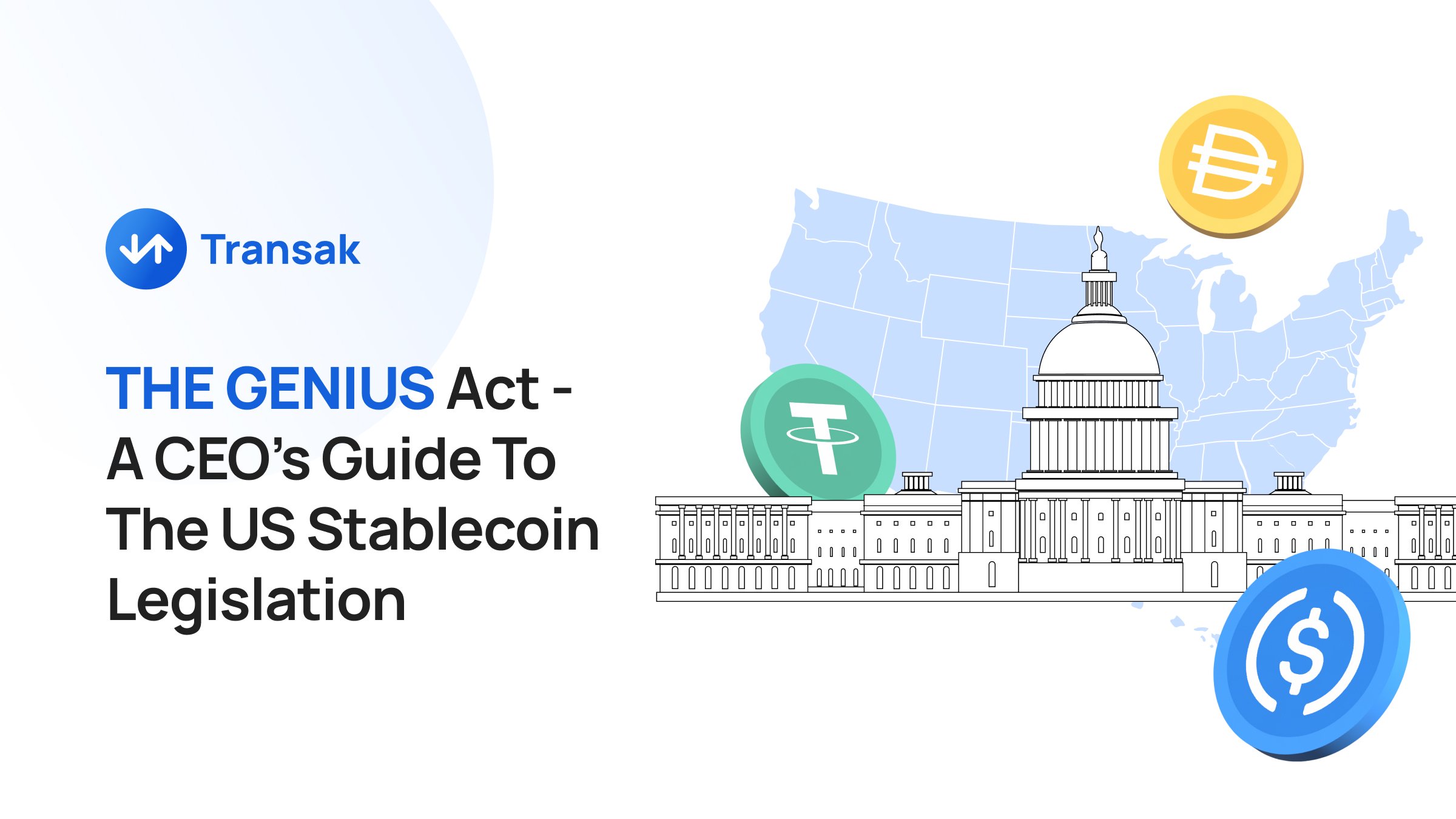Takeaways
Until recently, stablecoins in the U.S. operated in a regulatory gray area.
Recap: A stablecoin is a cryptocurrency whose value is pegged to another asset, typically a fiat currency like USD.
Regulators also worried that if a popular stablecoin wasn’t truly backed 1:1 by safe assets, a run or collapse could have broader financial stability implications. So, launching a stablecoin product in the US has felt like building on shifting sand.
But that era may finally be ending.
The GENIUS Act marks the clearest signal yet that the US is ready to embrace stablecoins
In short, as stablecoins grew into a $260+ billion market, U.S. lawmakers saw both promise and peril in these digital dollars and pushed to bring them under a federal regulatory framework.
Source: RWA.xyz
What Is The GENIUS Act?
The GENIUS Act (short for Guiding and Establishing National Innovation for U.S. Stablecoins Act) is the first federal stablecoin law of the United States. It is expressly dedicated to payment stablecoins, i.e., digital tokens pegged to fiat currencies like the U.S. Dollar.
The Act was signed into law by President Trump on 18 July 2025, after passing the Senate on June 17 and the House on July 17. It defines a “payment stablecoin” as a digital asset meant for payments or settlement, redeemable for a fixed monetary value, and intended to maintain a stable value relative to that peg.
“It’s good for the dollar and it’s good for the country.”
— Donald Trump (President of the United States, 2025)
What Problem Does The GENIUS Act Solve?
Until now, there was no clear path to launch and operate a stablecoin in the US. Issues required money transmitter licenses among many others, all without having a clear definition of the product or activity, i.e., stablecoins.
Also Read: US Money Transmitter License: Why It Matters For Web3
The GENIUS Act fixes those issues in the following ways:
- It created a federal pathway to issue stablecoins
- It places oversight under the CFTC
- It establishes standardized reserve, disclosure, and redemption rules
- It protects consumers through audits, transparency, and AML checks
From STABLE Act to GENIUS Act
The progression from introducing the STABLE Act to signing the GENIUS Act into law is a noteworthy tale of how a government can learn to stop worrying about stablecoins and invite innovation through regulation.
In 2020, the U.S. Congress flirted with a bold idea: “What if stablecoins were treated like banks?” The premise was that anyone issuing a dollar-pegged digital currency would operate like a traditional bank. Understandably, it sparked outrage from the crypto industry and soon faded away as unpassed legislation.
But the bill served an important purpose: it kickstarted the regulatory conversation and forced lawmakers, regulators, and the industry to ask hard questions:
- What happens when billions of dollars move around outside traditional banking rails?
- Who ensures stablecoin issuers have the reserves they claim?
- Could stablecoins undermine the U.S. dollar, or strengthen it?
While the STABLE Act didn’t pass, its ripple effects never stopped.
Enter, The GENIUS Act
iN 2025, With over $260 billion in stablecoin supply and daily transaction volumes rivaling Visa and Mastercard, the U.S. could no longer ignore the narrative. That’s when lawmakers introduced the GENIUS Act.
Unlike its predecessor, the GENIUS Act didn’t demand every issuer become a bank. Instead, it offered multiple on-ramps. Issues can get approved as a bank or just apply for a federal stablecoin license.
The GENIUS Act requires:
- 1:1 backing with safe assets like cash or short-term Treasuries
- Monthly audits and redemption guarantees
- Clear licensing paths for issuers
- Restrictions on Big Tech from launching private money at scale
And with this act now signed into law, the U.S. becomes the first major economy to pass a comprehensive stablecoin framework. So, now, banks are exploring tokenized deposits, fintechs are adopting on-chain payment rails with help of providers like Transak, and crypto-native firms are proactively becoming compliant issuers.
Benefits of the GENIUS Act
1. Strengthens the Dollar’s Role in the Digital World
The GENIUS Act helps the U.S. dollar remain the default currency for the internet.
By giving legal clarity and a compliant framework for USD-backed stablecoins, the Act ensures that future payment rails, global remittances, and on-chain economies use the dollar (not digital yuan, euro stablecoins, or private money from other nations). It turns private stablecoins into digital emissaries of the dollar, reinforcing U.S. influence in emerging global payment systems.
2. Discourages Rehypothecation
The GENIUS Act prohibits stablecoin issuers from lending out reserves or using them in risky ways. This eliminates hidden leverage, which is one of the root causes of past financial blowups (think FTX, Terra, or 2008 shadow banking).
The reserves backing your digital dollar stay where they should: accessible, safe, and untouched.
3. Unlocks Institutional Use of Stablecoins
Large financial institutions (banks, asset managers, fintechs) now have a green light. With clear licensing routes, mainstream companies can begin issuing, using, or integrating stablecoins into:
- Treasury operations
- Cross-border settlements
- On-chain finance
This will drive volume, utility, and real-world use cases, not just speculative trading.
4. Creates a New Class of Regulated Financial Institutions
The GENIUS Act introduces a federal license for non-bank stablecoin issuers. This creates an entirely new category of financial institutions that don’t lend or invest, but provide high-speed, programmable digital dollars.
It's a new financial primitive, similar to how money market funds or payment processors once emerged. These entities can:
- Interface with DeFi
- Power smart contract payments
- Operate globally, with U.S. legitimacy
5. Gives Builders a Legal Sandbox That Scales
Until now, developers and startups building payment tools with stablecoins had to worry about being shut down or blocked by compliance bottlenecks. With GENIUS in place, there’s a legal infrastructure that scales.
- Fintechs can plug into regulated stablecoins without fear of fallout
- Developers can build knowing the assets they use won’t be criminalized later
- Investors have more confidence in backing these ventures
6. Pulls Stablecoin Activity Back Onshore
A significant portion of stablecoin volume happens outside the U.S. due to unclear regulation. GENIUS offers a path to bring that activity home.
Companies like Tether and others may now relocate operations or compliance to U.S. jurisdictions and the U.S. benefits from economic activity, tax revenue, and employment.
7. Boosts U.S. Debt Demand Without Raising Taxes
Stablecoin issuers are now required to hold reserves in Treasury bills and other low-risk assets. This creates continuous, organic demand for U.S. government debt without relying on foreign buyers or retail investors.
Over time, this could absorb hundreds of billions in short-term Treasuries, quietly supporting U.S. fiscal strength through private-sector growth.
GENIUS Act’s Dual-Track Regulatory Model
The GENIUS Act sets clear expectations. Only permitted issuers can issue payment stablecoins in the United States. But instead of enforcing a one-size-fits-all regime, it offers two distinct regulatory paths.
Track 1: Federal Oversight
Entities can apply for a federal stablecoin license through the Office of the Comptroller of the Currency (OCC) or operate as a subsidiary of an FDIC-insured bank. These issuers fall under direct federal supervision, complete with reserve backing requirements, audit mandates, and redemption guarantees.
This track ensures nationwide uniformity, consistent risk management, and interoperability with federal systems.
Track 2: State-Qualified Issuers
Alternatively, stablecoin issuers can operate under a state license, if their home state’s framework is certified by the Stablecoin Certification Review Committee (SCRC), a federal panel led by the Treasury and including the Fed, OCC, and FDIC.
State-qualified issuers are subject to a $10 billion issuance cap (unless waived), but they benefit from local regulatory nuance while aligning with federal expectations.
GENIUS Act Implementation Timeline
The GENIUS Act takes effect on the earlier of the following two dates:
- 18 months after the date of enactment. Since it was signed into law on July 18, 2025, this would mean January 18, 2027
- 120 days after the final implementing regulations are issued by the relevant federal agencies. These regulations will define operational requirements, licensing procedures, and oversight protocols for stablecoin issuers.
Whichever comes first between those two triggers sets the law's effective date.
What Happens In The Transition Period?
The transitional phase gives time to align market practices with regulatory standards and allows companies to avoid abrupt disruption.
- Regulators (OCC, Treasury, Federal Reserve, etc.) will issue detailed rules
- Current stablecoin issuers like Circle and Tether will need to apply for a license or qualify under the new framework
- States that want to certify their licensing regimes must submit them for federal review
- Foreign issuers await clarity on how equivalence or reciprocity will work
Conclusion
The passage of the GENIUS Act could be the beginning of a larger fintech revolution. Coinbase CEO Brian Armstrong lauded the stablecoin law as “the beginning of a big financial revolution in the U.S.”, and emphasized that now 7% of the crypto market (stablecoins) is regulated, the focus will turn to the other 93%.
Also, the prohibition on interest might even play out positively by reassuring users that stablecoins aren’t risky investment products but just digital cash, making them more comfortable using them as a medium of exchange.






